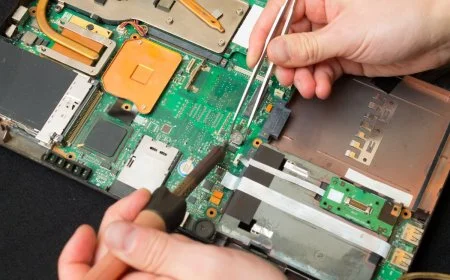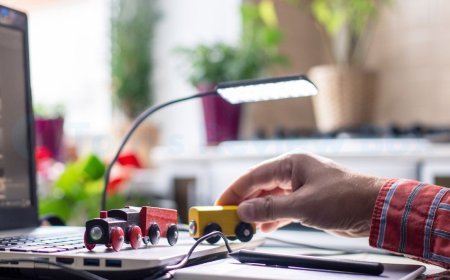How to Open an HP Pavilion Laptop: Ultimate Guide
Learn how to open an HP Pavilion laptop with our ultimate guide. Get step-by-step instructions and expert tips to easily dismantle and replace parts.

Ever wondered what lies beneath the sleek exterior of your HP Pavilion 15 Series laptop? Understanding the disassembly process is crucial before embarking on any upgrades. In this guide, we'll delve into the disassembly procedure for HP Pavilion 15 Series laptops, shedding light on its significance and the common reasons necessitating it.
"Success is where preparation and opportunity meet." - Bobby Unser
Whether you're a tech enthusiast or encountering performance issues, knowing how to open up your HP Pavilion 15 Series laptop is invaluable. Join us as we explore the ins and outs of this popular laptop series, equipping you with the knowledge needed to tackle upgrades and maintenance confidently.
Essential Tools and Screwdrivers for Opening HP Pavilion Laptops
Types and Sizes of Screwdrivers
Different types and sizes of screwdrivers are required for dismantling an HP Pavilion laptop. The most common ones include Phillips, Torx, and flathead screwdrivers. Each serves a specific purpose in removing different screws within the laptop.
Importance of Using Anti-Static Tools
Using anti-static tools during the disassembly process is crucial to prevent damaging sensitive electronic components. Anti-static wrist straps and mats help discharge any static electricity from the body, ensuring that it does not transfer to the delicate internal parts of the laptop.
Overview of Essential Tools Needed
Apart from screwdrivers, several essential tools are necessary for opening an HP Pavilion laptop. Spudgers, tweezers, and pry tools are invaluable for carefully prying open clips, disconnecting cables, and maneuvering small components during the disassembly process.
Tips on Where to Purchase High-Quality Tools
When looking to purchase high-quality tools for opening HP Pavilion laptops, consider reputable hardware stores or online retailers specializing in computer repair equipment. Opting for well-reviewed brands ensures durability and precision when working with intricate components.
Step-by-Step Guide for Dismantling an HP Pavilion 15 Series Laptop
Detailed Instructions on Removing the Bottom Case
To start, flip the laptop over and locate the screws securing the bottom case. Use a suitable screwdriver to carefully remove all the screws.
Identifying and Removing Specific Screws in a Systematic Order
Begin by organizing the removed screws according to their placement on the laptop. This will simplify reassembly later. Then, refer to a guide or manual to identify any hidden or specialty screws that may be present.
Precautions When Disconnecting Cables and Components Inside the Laptop
Before disconnecting any cables or components, ensure that you are grounded to prevent static discharge. Gently detach any connectors by using a spudger or your fingertips, taking care not to damage them.
Remember, patience is key when dismantling an HP Pavilion 15 Series laptop. Rushing through this process can lead to mistakes and potential damage to delicate internal components.
Always keep track of where each screw belongs; consider using a magnetic mat or labeled compartments if needed.
Be mindful of cable routing and connections when removing the bottom case; taking reference pictures before disassembly can be extremely helpful during reassembly.
When handling internal components, avoid touching any gold connectors as oils from your skin can cause connectivity issues.
In addition to following these steps, it's crucial to consult specific guides or tutorials tailored for your exact model of HP Pavilion 15 Series laptop.
Upgrading and Replacing Parts in HP Pavilion 15 Series Laptop
Benefits of Upgrading Components
Upgrading the RAM or storage can significantly enhance your laptop's performance. Increased RAM results in smoother multitasking, while a larger SSD boosts overall system responsiveness.
Considerations Before Upgrading
Ensure compatibility with the laptop model and existing components. Check for warranty implications before making any changes to the hardware.
Steps for Replacing RAM or Storage
-
Prepare Your Workspace
-
Find a well-lit, clean area to work on.
-
Gather necessary tools like screwdrivers and an antistatic wrist strap.
-
Power Off and Unplug
-
Shut down the laptop completely.
-
Disconnect all power sources, including the charger and battery.
-
Accessing Internal Components
-
Remove the screws from the bottom panel using a suitable screwdriver.
-
Gently pry open the bottom cover to access internal parts.
-
Replacing RAM
-
Locate the existing RAM modules.
-
Release the clips holding them in place and carefully remove them.
-
Align the new RAM module correctly and firmly press it into place until clips lock it in.
-
Upgrading Storage
-
Locate the existing storage drive, usually an HDD or SSD.
-
Unscrew any brackets securing it in place and disconnect any cables attached to it.
-
Install the new storage device by connecting cables and securing it with screws if necessary.
-
Reassembling Your Laptop
-
Carefully reattach any cables that were disconnected earlier.
-
Place the bottom panel back on and secure it with screws.
-
Power On and Verify
-
Power up your laptop to ensure that it recognizes the upgraded components.
Tips for Successful Upgrades
-
Handle all components delicately to avoid damage from static electricity or physical mishandling.
-
Double-check that all connections are secure before reassembling your laptop.
Potential Risks of DIY Upgrades
-
Accidental damage during installation may void your warranty if not done carefully.
-
Incompatibility issues could arise if proper research isn't conducted beforehand.
Exploring Upgrade Options for HP Pavilion 15 Series Laptops
Upgrading your HP Pavilion 15 Series laptop can significantly enhance its performance and extend its lifespan. Let's delve into the various upgrade options available and how they can benefit your device.
Comprehensive Guide on Upgrading Components
-
RAM: Increasing RAM can improve multitasking capabilities and overall system speed.
-
Storage: Upgrading to a solid-state drive (SSD) can result in faster boot times and improved data transfer speeds.
-
Battery: Replacing an old battery with a new one can restore the laptop's portability and usage time.
-
Other Components: Upgrading other components like the CPU or GPU may require professional assistance due to their complexity.
Sourcing Compatible Replacement Parts
-
Research online resources, such as HP's official website or authorized third-party sellers, to ensure you're purchasing genuine, compatible parts for your specific model.
-
Seek advice from tech forums or community groups where users share their experiences with different replacement parts for HP Pavilion laptops.
Understanding Warranty Implications
-
Check your warranty terms and conditions before replacing any components. Some upgrades might void the warranty, while others may not.
-
If unsure about warranty implications, consult with an authorized HP service provider for guidance.
Potential Performance Improvements
Upgrading RAM from 4GB to 8GB or higher can lead to smoother multitasking experiences, especially when running multiple applications simultaneously. Replacing a traditional hard drive with an SSD can significantly reduce boot times and application loading speeds, enhancing overall system responsiveness. Installing a higher-capacity battery can extend the laptop's unplugged usage time, providing more flexibility for on-the-go use.
Understanding the Disassembly Process for HP Pavilion 15 Series Notebooks
Overview of Potential Upgrade Options Beyond Standard Hardware Replacements
There are various options beyond standard hardware replacements that can significantly enhance its performance and functionality.
-
Upgrading Storage: Consider replacing the existing hard drive with a solid-state drive (SSD) for faster boot times and improved overall system responsiveness. An SSD can drastically reduce loading times for applications and improve the laptop's multitasking capabilities.
-
Adding More RAM: Upgrading the RAM capacity can lead to smoother multitasking, faster data access, and improved overall system performance. Increasing the RAM from, for example, 8GB to 16GB, can make a noticeable difference in handling resource-intensive tasks such as video editing or gaming.
-
Enhancing Display: If the user prioritizes visual experience, they may consider upgrading the display panel to a higher resolution or opting for a screen with better color accuracy. This upgrade is particularly beneficial for graphic designers, photographers, and video editors.
-
Improving Cooling System: Investing in an enhanced cooling pad or an internal cooling solution can help manage temperatures more effectively during intense usage scenarios. This can prevent thermal throttling and ensure consistent performance over extended periods.
Exploring External Accessories or Peripherals That Can Enhance Functionality
Aside from internal upgrades, users can explore various external accessories or peripherals that can complement and enhance the functionality of their HP Pavilion 15 Series laptop.
-
External Monitors: Connecting an external monitor allows for expanded screen real estate, making it ideal for multitasking or enhancing the viewing experience while working on complex projects.
-
Docking Stations: A docking station provides additional connectivity options such as extra USB ports, Ethernet connections, and support for multiple displays. This is especially useful for users who require a versatile workspace setup at home or in an office environment.
-
External Graphics Card Enclosures (eGPU): For users requiring enhanced graphical performance for gaming or professional applications, an eGPU enclosure paired with a dedicated graphics card offers a significant boost in visual processing capabilities.
Considerations When Choosing Between Different Upgrade Paths Based on User Requirements
When contemplating various upgrade paths for an HP Pavilion 15 Series laptop, it's essential to consider individual user requirements and preferences before making any decisions.
-
Budget Constraints: Evaluate the budget available for upgrades and prioritize enhancements based on affordability and immediate needs.
-
User Usage Patterns: Understand how the laptop is primarily used - whether it's for gaming, content creation, productivity tasks, or general web browsing - to determine which upgrades would yield the most benefits.
-
Long-Term Investment: Assess whether certain upgrades align with long-term usage plans to avoid investing in components that may become obsolete quickly due to evolving technology trends.
-
Compatibility Checks: Ensure that chosen upgrades are compatible with the specific model of HP Pavilion 15 Series notebook being used before making any purchases.
Detailed Disassembly of HP Pavilion 15 Series Model
Tools and Equipment
To open an HP Pavilion laptop, you'll need the following tools and equipment:
-
Screwdriver set (with various head types)
-
Anti-static wrist strap
-
Plastic spudger or opening tool
-
Tweezers
-
Cleaning brush or compressed air can
Precautions to Take
Before disassembling your HP Pavilion 15 Series laptop, it's crucial to take some precautions:
-
Power off the laptop and disconnect all cables.
-
Wear an anti-static wrist strap to prevent damage from static electricity.
-
Work on a clean, flat surface with good lighting.
Opening the Laptop Case
Here's how to open the case of an HP Pavilion 15 Series model:
-
Flip the laptop over and remove the battery if possible.
-
Unscrew all visible screws on the bottom cover using a suitable screwdriver.
-
Use a plastic spudger or opening tool to carefully pry open the case around its edges.
Removing Internal Components
Once the case is opened, follow these steps to remove internal components:
-
Gently disconnect any attached cables such as those for the keyboard, touchpad, and screen.
-
Unscrew and remove the hard drive, RAM modules, and any other removable components.
-
Carefully lift out the motherboard, ensuring no cables are still connected.
Reassembling the Laptop
After completing any necessary repairs or upgrades, reassemble your HP Pavilion 15 Series laptop by following these steps:
-
Place the motherboard back into position and reconnect all cables securely.
-
Install any removed components such as RAM modules and hard drive back into their respective slots.
-
Close the laptop case carefully by aligning it properly before pressing down around its edges.
Mastering the Art of Opening and Upgrading HP Pavilion 15 Series Laptops
You've now got the tools and knowledge to embark on your journey of opening and upgrading your HP Pavilion 15 Series laptop. It's like having a trusty toolbox by your side as you venture into the inner workings of your device. Remember, it's all about taking it one step at a time, just like following a recipe or putting together a piece of furniture. Now that you've learned the ropes, it's time to roll up your sleeves and get hands-on with your laptop. Dive in, explore, and don't be afraid to tinker – after all, that's how we learn best!
FAQs
Can I upgrade my HP Pavilion laptop without voiding the warranty?
Yes, you can upgrade certain components like RAM and storage without voiding the warranty. However, it's essential to refer to HP's warranty terms and conditions for specific details.
What are some recommended upgrades for an HP Pavilion 15 Series laptop?
Common recommended upgrades include installing an SSD for faster boot times and improved overall performance, increasing RAM for better multitasking capabilities, and replacing the battery if it's degraded over time.
Do I need special tools to open an HP Pavilion laptop?
Yes, you'll need basic tools such as screwdrivers (Phillips #0 or #1) and prying tools to safely open an HP Pavilion laptop without causing damage.
Is it difficult to reassemble an HP Pavilion laptop after upgrading components?
Reassembling an HP Pavilion laptop can be intricate but manageable if you carefully follow the disassembly steps in reverse order. Patience is key when handling delicate components during reassembly.
Will upgrading my HP Pavilion void my support from HP customer service?
Upgrading certain components should not affect support from HP customer service as long as the modifications are done within the guidelines provided by HP.
What's Your Reaction?







































![MacBook Pro M5: All the features and specs you need to know [LEAKS REVEALED]](https://tomsreviewbox.com/uploads/images/202502/image_430x256_67bd6d7cd7562.jpg)















![How to Fix Acer Laptop Black Screen Issue [Causes & Solutions]](https://tomsreviewbox.com/uploads/images/202408/image_430x256_66ab529c8a89f.jpg)











